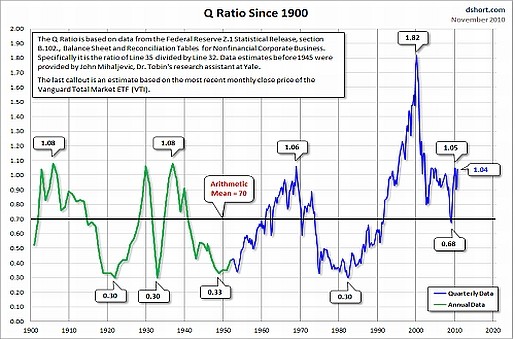S&P Price To Book
Post on: 26 Май, 2015 No Comment

%img src=http://feedads.g.doubleclick.net/
a/Yx6vIaZCq9VzCZe03wZ1Qlx-n10/0/di /%
%img src=http://feedads.g.doubleclick.net/
a/Yx6vIaZCq9VzCZe03wZ1Qlx-n10/1/di /%
Investors will often look at the P/E ratio of the S&P 500 in order to gauge how expensive stocks are. Earnings, the denominator of that equation, are quite volatile, however. In a year like this one, where massive write-downs plague income statements, it is difficult to determine the market’s true earning power.
Another method to gauge investor sentiment, though not nearly as popular, is the market’s price to book ratio. Unlike earnings, book values are not nearly as volatile (unless of course, you are an over-leveraged bank), and therefore they can give us a decent indicator of how the market is valuing company assets. Courtesy of Comstock Partners, here is the price to book value of the S&P 500 over the last 30 years (original version here ):
There are a couple of interesting observations to note in the above chart. First, on a price to book basis, during this recession the market did not fall to the depressed levels seen in the late 1970s. Second, the market’s price to book value currently appears to be fairly close to its 30-year average (denoted by the horizontal blue line), despite the fact that the outlook for economic growth appears tepid.
Of course, there are a number of factors that make historical comparisons of price to book values difficult. Accounting methods of how book value is calculated have changed over the years, with an increasing trend towards making book value better reflect market value. Furthermore, there has been a shift when it comes to industries in the S&P 500, with manufacturing companies playing a decreasing role while knowledge-based companies (e.g. software, consulting, other services etc.), where hard-assets are not a determining factor, comprise a larger portion of the index.
For the above reasons, long-term comparisons of historical price to book ratios can be problematic. Nevertheless, investors can look at the price to book ratio over recent periods as a decent gauge of investor sentiment. Clearly, price to book ratios fell dramatically from their 2008 highs, but a large rally has resulted in a recovery of a significant portion of those losses. The above chart won’t tell you where the price to book ratio will go, but it will tell you that investor sentiment has recovered to a large extent and that downside risks have increased as a result.
%img src=http://feeds.feedburner.com/
r/BarelKarsan/
4/up84Pep5QSM /%
2015 Benzinga.com. Benzinga does not provide investment advice. All rights reserved.














